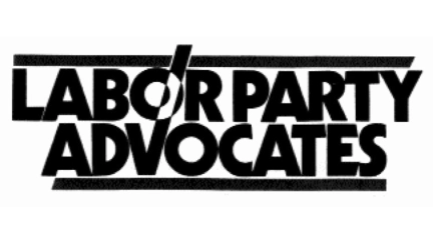Millie Phillips on Why We Need an Independent Labor- and Community-Based Party


Originally published on 10/5/2019
[Note: Following are excerpts from a presentation by Millie Phillips in Sacramento, Calif., in September 2018. Phillips is a member of the Editorial Board of The Organizer Newspaper.]
Twenty years ago, I was one of the local activists leading the movement for a labor party, which, in the moment, felt like the culmination of an almost life-long dream: having a party of our own. And by “our” I mean a party grounded in the needs and desires of the working class as a whole and built by the resources of the organized working class, AKA labor unions.
There was a lot that was very positive about this movement, which took place throughout the 1990s into the early 2000s. Here in the Bay Area, some 15 union locals endorsed. Regular meetings of our chapter attracted over a 100 activists for several years running. Nationally our founding convention attracted almost 1500 elected union and chapter delegates and it adopted a program which, though it could use a lot of updating, is still a decent model of what a Labor Party ought to raise. Many of you in this room remember.
Yet, after a few annual conventions, the party fizzled, the victim of many factors, all of which provide partial explanations, but none of which was solely responsible. The most obvious, perhaps, was that the party declined, with a few local exceptions, such as South Carolina, to run candidates for office. In spite of its open advocacy for a new party of labor, in practice, it functioned as a pressure group on the Democrats, which frankly made it safe for the top leaders of unions. Now, unions and social movements have always pressured the Democrats on issues and policies; sometimes with partial or temporary victories, occasionally with good reforms that last for a few generations. Nothing wrong with that when it comes to issues, but a labor party that does only that is redundant, just an extra set of meetings in an already busy activist’s schedule. When people hear the word party, they think elections and candidates, not yet another multi-issue coalition.
However, with much hindsight, I think another one of the biggest factors was that organized labor was trying to go it on its own. The conclusion I reached was that we need, from the start, a collective effort that includes organized labor, absolutely, and also includes all communities negatively impacted by capitalism. All working class people are exploited, by definition, regardless of other factors. The vast majority of those who are oppressed in this country by race, immigrant status, national origin, and gender, are also working class. The vast majority of the working class, regardless of other forms of oppression, is not organized. The vast majority of those traditionally called middle class are actually working class and are downwardly mobile in a way unprecedented since the Great Depression of the 1930s.
In all fairness to the Labor Party effort, labor itself is a multiracial, multinational movement. For example, thanks to the societal and legal shifts of the Civil Rights, workers of color have joined unions in much higher percentages than white workers ever since the 1970s. Within the Labor Party we had activists from many communities and we did adopt a program that spoke powerfully to the interests of most, but by limiting it to organized labor, we failed to gain a much larger constituency and missed out on many essential voices. Today, with so many vibrant movements of people fighting back who are not in labor unions, and a revived labor movement that is much better at community solidarity, outreach, and allyship than it was in the 1990s, it would be a far worse mistake not to include unorganized workers or equal representation in the leadership from oppressed and frontline communities. Barely 10% of public sector workers are organized and only 6% of the privately employed. We can’t leave out the rest of us.
Yet, labor is still an essential part of this effort. Why? Some of that is practical: labor still has significant money and volunteer resources. One major union alone raised and spent close to $90 million on the Hillary Clinton campaign. Imagine how we could use that money. Also, despite the decline and defeats, labor is rising up again, along with workers trying to organize and join unions. Young people working in fast food and retail – the fight for $15, groups like Rise Up and OUR Walmart and Young Workers United. Locally our labor council has representatives from these groups; an act of solidarity and inclusion that was unheard of in the 1990s. And we are beginning to win again. Teachers in West Virginia and Oklahoma and Arizona struck even when it was illegal and actually won significant improvements in wages, benefits, and working conditions. Workers in Missouri rejected Right to Work. I ‘ve lived in Missouri and Arizona – when workers fight back, gain tremendous community support, and win in places like those, that is truly significant. Here we are winning victories, too, such as our k-12 teachers did with a new, militant leadership and saving City College and making it free to city residents. Janitors struck and won a much improved contract. Unions are supporting the immigrant rights movement and helping form groups like Bay Resistance dedicated to uniting us across other divisions. And we are gearing up for more: Go Local 2 UNITE HERE in their kickoff campaign for hotel contracts starting with Marriott, the world’s largest hotel chain. Join the Labor Day march!
I hop that in our discussion today we will also take up the rising militancy of youth and the rapidly growing and now majority support throughout the population for the idea of another party. Now is absolutely not the time to let the Democratic Party use Trump to suck us back into the two-party, never-draining swamp. Let’s face it, Trump would never be in office in the Democrats hadn’t sold out everything we in this room stand for. We aren’t traitors or dupes of the Russians – we are the working class majority. We want racial and gender equality, but not the current race to the bottom in the name of equality promoted by those at the top. We want a living wage, housing for all, civil liberties, free education, community control of law enforcement personnel, full rights for immigrants, a single payer Medicare for all system, strengthening Social Security, taxing the rich, ending the war economy. We want a rational response to climate change, the consequences of which, if unchecked, will render all our other demands irrelevant. Ultimately, we want a new system and the sooner the better. And I challenge you, give me a single reason why any of us should settle for less?
We will never get it from the Democratic Party or any institution beholden to the capitalist class. We need nothing less than a movement grounded and built from below by local organizing, leading to a national effort for a new working class party. Back in the 1990s, we had the right idea. The objective conditions were ripe then, too. But, today, we have the right time and, let’s get brutally honest, not enough time left to risk waiting any longer. The objective conditions are rapidly getting past ripe, and, as more and more of us come up against the utter depravity of capitalism in our own lives, now we see the subjective conditions emerging in a way unprecedented in our lifetimes. It’s time!

